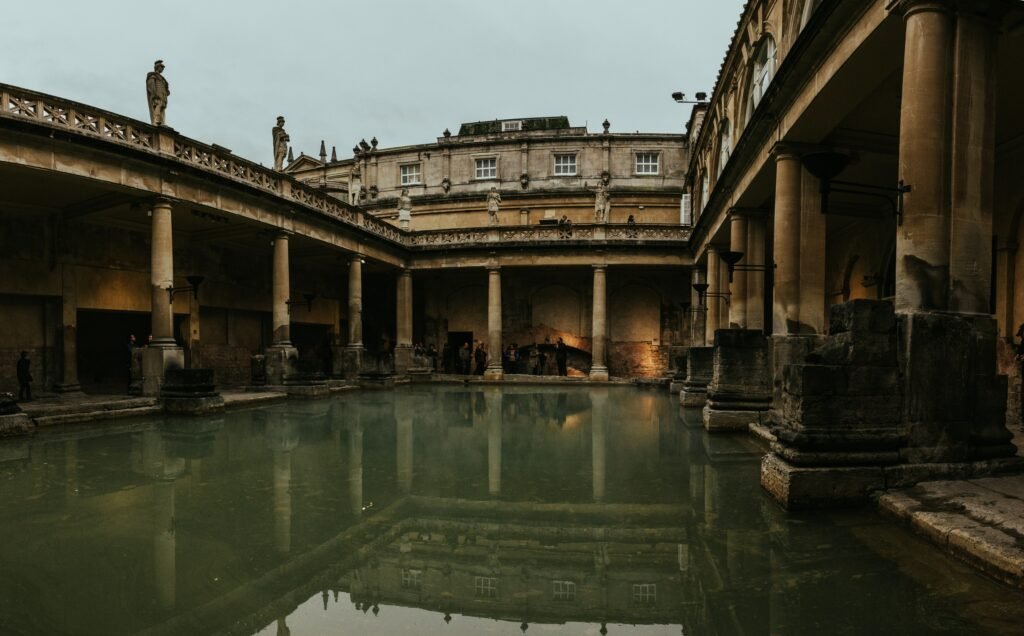
The Cotswolds are one of the best destinations to visit for anyone who’s fascinated by Roman heritage. Being one of the earliest places in Britain to be settled by the Romans, the Cotswolds boast a plethora of historic sites that let you travel back in time. From the Chedworth Roman Villa to the Cirencester Roman Amphitheatre, the area is rich in Roman relics.
One of the most iconic Roman heritage sites in the area are the Roman Baths in the city of Bath. Built by the Romans around 70AD, they are a major tourist attraction on the southern tip of the Cotswolds – a must-see for anyone fascinated by Roman heritage.
Is the city of Bath in the Cotswolds?
First, let’s get one thing out of the way: Is Bath even in the Cotswolds? With the borders of the Cotswolds hardly being an obvious line, this question is subject to debate. Some argue the borders of the Cotswolds only skirt Bath, while others consider it obvious that Bath is indeed in the Cotswolds. The city of Bath lies at the very southern tip of the Area of Outstanding Natural Beauty (AONB), and whether the city itself may or may not officially be within those borders, it certainly is of outstanding beauty and well worth a visit if you want to walk where once Romans walked.
Healing hot springs from Roman times
The healing hot springs that naturally emerge from the ground were discovered centuries ago. The first to find the healing waters in Bath were the Celts, who built the first shrine here. After the Romans invaded Britain some 2,000 years ago, they built a formal temple complex and turned the hot springs into a grand spa, which flourished between the first and fifth centuries AD. The remains of the Roman bathing complex house the natural hot springs that flow from the ground until this day and can still be visited now. In fact, the Roman Baths in the city of Bath are one of the best-preserved Roman spa remains in the world and a fascinating site to soak up Roman history.
Visiting the Roman Baths
The complex consists of the Sacred Spring, the Roman Temple, the Roman Bath House, and the Museum, as well as the Georgian Pump Room, offering a range of sites to visit and learn about the fascinating history of the baths. You can trace 2,000 years of history as you discover how the baths were used throughout the centuries, from the Romans all the way through to Victorian times.
The highlight is the open-air Great Bath that’s filled with the steaming spring water, with thousands of litres of the naturally heated water emerging from the Earth’s crust and pouring into the pool each day. If you are already thinking of bringing your bathing suit and taking a dip in the healing spring water, you may be disappointed to find out you can’t actually go into the baths. You can, however, take a sip of the freshly pumped healing spring water at the Pump Room Restaurant. It’s not exactly fresh and delicious, though – you’ve been warned.
Roman history in modern times
As you walk on the pavement the Romans used to tread on and gaze at the fascinating historic remains, you take a trip back in time. It’s an era that still fascinates people today, with Roman history frequently finding its way into our modern pop culture. Roman times offer endless material for adventures within games that let players experience the ancient stories of the Romans digitally. One example is Age of Empires from 1997 which got a brand-new remake in 2018. With the Rise of Rome expansion, players get immersed in the Roman Empire.
Total War: Rome 2 is one of the best strategy games set in a historic era and takes players to antique Rome with a deep single-player campaign to soak up the Roman history. This fascinating era has also found its way into the realm of modern casino games, as online casinos such as VegasSlotsOnline feature Roman history on many of their online slots. These depict a plethora of topics on their reels, with typical symbols of Roman times shown on slots such as Champions of Rome, Roman Empire and Legendary Rome. All these examples show how the Roman times are still celebrated today.
The Cotswolds are a must-visit for anyone fascinated by Roman history. Follow the Roman trail and immerse yourself in deep history at the many Roman heritage sites, such as the impressive Roman Baths in the city of Bath.



